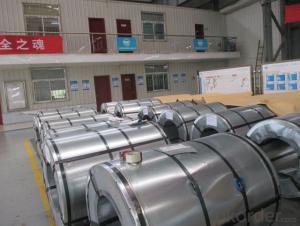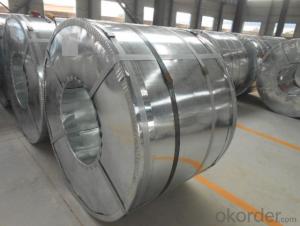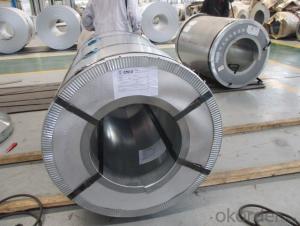STAINLESS STEEL COILS with seaworthy export package
- Loading Port:
- China main port
- Payment Terms:
- TT OR LC
- Min Order Qty:
- 50 m.t.
- Supply Capability:
- 20000 m.t./month
OKorder Service Pledge
OKorder Financial Service
You Might Also Like
STAINLESS STEEL COILS
Packaging & Delivery
Packaging Detail: seaworthy export package
Delivery Detail: on request
Specifications
1. more than 10 years’ experience on this field
2. advanced equipments
3. competitive price
4. soonest delivery
Product Description :
Commodity
STAINLESS STEEL COILS
Technical Standard: Steel Grade & Standard:J1
Surface Treatment:NO.1
Hot rolled Annealed and Pickled(HRAP)
Grade: J1 , Prime quality
Mill Edge. No connection point in each coil. Component: Ni:1% , Cu: 0.65-0.9%, Cr: 13%, Mn: 10–12%, C: 0.09-0.12%
Package: Properly packed for ocean freight exportation in 20''container
Application:: home appliances, constructions, building, machineries
Our Advantages :
1. Expertise:
More than 10 years of manufacture: we know how to properly handle every step of production.
2. Competitive price:
We can offer competitive prices to our customers.
3. Accuracy:
We have excellent technicians and leaders, which can ensure our products are exactly what you want.
4. Materials:
All steel coils are made of high-quality raw materials.
5. Certificate:
Our products are certified by ISO9001.
6. Productivity:
We have large-scales of production lines,, which can guarantee all your orders will be finished in earliest time.
The furnace heating style: improved Sendzimir heating technology
Hourly output: max.76.3t/h
Process after coating: tension leveling, Passivation or oiling
Our Service
Our quality
Test Equipments of Prepainted Galvanized Steel Coil : Salt-spray tester; Atomic absorption spectrophotometer; Rockwell typer hardness tester; Tensile test machine; Metrohm titration; Laboratory Bend test machine.
Our packing
Properly packed for ocean freight exportation in 20''container, galvanized metal fluted rings on inner and outer edges, galvanized metal & waterproof paper wall protection disk, galvanized metal & waterproof paper around circumference.
R&D department
R&D department concentrates on researching and developing reliable products with best quality. The quality department test and control every process of production to guarantee the best quality of product
- Q:What is the role of steel coils in the manufacturing of pipes and tubes?
- The manufacturing process for pipes and tubes heavily relies on the crucial role played by steel coils. These coils serve as the primary raw material used in the production of these products. To produce steel coils, molten steel is processed through a series of rolling mills that shape it into flat, thin sheets. These sheets are then wound into coils for the purpose of easy transportation and storage. During the manufacturing process of pipes and tubes, steel coils are unwound, and the flat sheets are subjected to a series of machines and processes. Typically, the first step involves cutting the steel sheets into the desired width and length. This is followed by forming the sheets into a cylindrical shape through a process known as roll forming or continuous forming. The edges of the sheet are welded together to create a seamless pipe or tube. Steel coils offer numerous advantages in the manufacturing process. Firstly, they ensure consistent and reliable quality. The production of coils guarantees uniform thickness and strength throughout the entire length of the sheet, resulting in consistent properties in the final pipes and tubes. This is especially crucial for applications that demand high structural integrity and reliability. Secondly, steel coils facilitate efficient production. The continuous supply of coils ensures a steady flow of raw material, minimizing downtime and enhancing productivity. Coils also enable automated processes, such as roll forming, which can be extremely efficient and cost-effective. Moreover, steel coils provide flexibility regarding size and dimensions. Coils can be manufactured in various widths and thicknesses, enabling manufacturers to tailor the size and specifications of the pipes and tubes to meet their specific requirements. This flexibility empowers the production of pipes and tubes for a wide range of applications, from plumbing and construction to oil and gas pipelines. In conclusion, steel coils are indispensable raw materials in the manufacturing of pipes and tubes. They offer consistent quality, facilitate efficient production, and provide flexibility in terms of size and dimensions. Without steel coils, the production of pipes and tubes would be significantly more challenging and less efficient.
- Q:What is current price of steel in US market?
- here okorder /
- Q:What is the typical lead time for ordering steel coils?
- The typical lead time for ordering steel coils can vary depending on factors such as the supplier, quantity required, and current market conditions. However, it is common for lead times to range from a few weeks to several months.
- Q:Well the other day i told my friend that when you put a compass near steel it will screw up and he said only magnets do that then i showed him and it worked then he said: that'ss because steel has its own magnet in it coz it builds up static electricity is that correct what he said? thanks
- no it is not, he made that up steel is a conductor and can't build static electricity. Compass needle is a magnet and as such was attracted to steel .
- Q:What are the common coil processing methods?
- The common coil processing methods include slitting, blanking, leveling, shearing, and recoiling.
- Q:Is condensation on steel caused from water being pulled out or is the condensation formed from the air around the steel object?
- steel is made from very high temperature iron. water would vapourize at such high temperature. adding a little bit carbon, mix it well with iron, quench (dip it into water); water around the ingot would sizzle. water inside the ingot would vapourize. then the iron turns into steel called martensite. condensation means water are materializing from the air on cold surfaces. there is no water molecules inside steel.
- Q:How are steel coils processed for slitting or edge conditioning?
- Steel coils are typically processed for slitting or edge conditioning through a series of steps. First, the coils are uncoiled and inspected for any defects or damages. They are then leveled and straightened to ensure a uniform thickness and flatness. Next, the steel is fed through a slitting machine, which uses rotating circular blades to cut the coil into narrower strips. These strips can be further processed for edge conditioning, where the edges are trimmed or profiled to meet specific customer requirements. This can be done through various methods such as shearing, deburring, or edge rolling. Overall, the process involves precision cutting and shaping techniques to transform the steel coils into desired slitted or edge-conditioned products.
- Q:What is the purpose of steel coils?
- The purpose of steel coils is to efficiently store and transport large quantities of steel in a compact and organized manner.
- Q:What could the impurities in steel wool be?And why are they there?Thanks for your help :)
- Impurities in steel wool would be of the elemental type. I'm sure steel wool is a mixture of different low grade not good for much of anything else materials. There may be excessive impurities such as lead, cobalt, boron, aluminum etc... in the steel wool. There may also be solvent residue on the wool i.e cleaner, lubricant etc.. I'm sure every batch is different - I know the iron level is high thats what makes them rust quickly.
- Q:What are the different methods of testing steel coils for quality control?
- Steel coils undergo various methods for quality control testing to ensure they meet the necessary specifications and standards. These methods encompass visual inspection, dimensional measurement, hardness testing, tensile strength testing, chemical analysis, coating thickness measurement, surface roughness measurement, ultrasonic testing, and magnetic particle inspection. Visual inspection is the most fundamental technique, involving a thorough examination of the coils for surface defects like scratches, dents, or irregularities. This method enables the identification of visible defects in the material. Dimensional measurement, on the other hand, utilizes tools such as calipers, micrometers, or laser measuring devices to evaluate the dimensions of the steel coils. The measurements are compared against specified tolerances to ensure they meet the required standards. To assess the resistance of the steel coils to indentation or penetration, hardness testing is performed. This examination helps evaluate the material's strength and durability. Common hardness testing methods include Rockwell, Brinell, and Vickers hardness tests. Tensile strength testing measures the maximum tensile stress a steel coil can endure before breaking or deforming. This test helps determine the material's strength, elasticity, and compliance with the required specifications. Chemical analysis is crucial in testing the composition of the steel coils to verify the presence of specific elements in the desired amounts. This ensures that the coils are made from the correct grade of steel and comply with the required chemical composition standards. In cases where the steel coils have a protective coating, it is vital to measure the thickness of the coating. Non-destructive testing methods like magnetic induction or eddy current testing are typically employed for this purpose. The coating thickness is compared against the specified requirements to ensure it provides adequate protection. Surface roughness testing evaluates the smoothness or roughness of the steel coil's surface using instruments like profilometers or roughness testers. This testing method guarantees that the coils meet the required surface finish standards. Ultrasonic testing utilizes high-frequency sound waves to detect internal defects like cracks, voids, or inclusions within the steel coils. This non-destructive testing method provides valuable information about the structural integrity of the coil. Magnetic particle inspection is employed to identify surface and near-surface defects in steel coils. By applying magnetic particles to the surface and detecting any magnetic leakage caused by defects using magnetic sensors, this technique effectively detects cracks and other surface abnormalities. By combining these testing methods, manufacturers ensure that the steel coils produced meet the necessary quality standards and are suitable for their intended applications.
1. Manufacturer Overview |
|
|---|---|
| Location | |
| Year Established | |
| Annual Output Value | |
| Main Markets | |
| Company Certifications | |
2. Manufacturer Certificates |
|
|---|---|
| a) Certification Name | |
| Range | |
| Reference | |
| Validity Period | |
3. Manufacturer Capability |
|
|---|---|
| a)Trade Capacity | |
| Nearest Port | |
| Export Percentage | |
| No.of Employees in Trade Department | |
| Language Spoken: | |
| b)Factory Information | |
| Factory Size: | |
| No. of Production Lines | |
| Contract Manufacturing | |
| Product Price Range | |
Send your message to us
STAINLESS STEEL COILS with seaworthy export package
- Loading Port:
- China main port
- Payment Terms:
- TT OR LC
- Min Order Qty:
- 50 m.t.
- Supply Capability:
- 20000 m.t./month
OKorder Service Pledge
OKorder Financial Service
Similar products
New products
Hot products
Related keywords





























